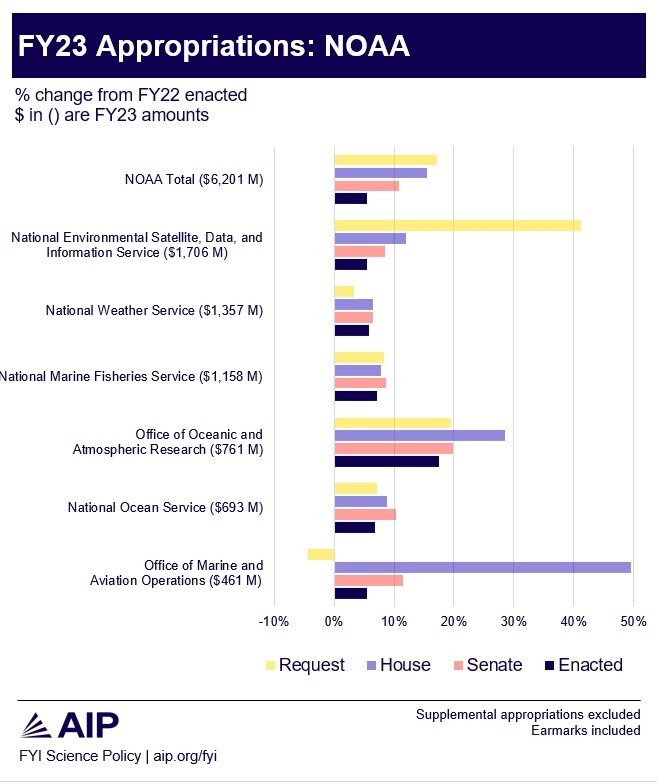
FY23 Budget Outcomes: National Oceanic and Atmospheric Administration
Congress increased the base budget of the National Oceanic and Atmospheric Administration by 6% to $6.2 billion for fiscal year 2023, short of the 17% increase the Biden administration requested .
However, the appropriations legislation also provided NOAA with $828 million in supplemental funds, which follow the nearly $6.3 billion the agency received through the Inflation Reduction Act (IRA) and the Infrastructure Investment and Jobs Act (IIJA). Most of these supplemental appropriations are for environmental conservation and resilience efforts, while a significant portion is for upgrades to data collection, forecasting, and supercomputing infrastructure.
Within NOAA’s base budget, Congress increased funding for the Office of Oceanic and Atmospheric Research (OAR) by 17% to $761 million, nearly matching the requested 20% increase, but it did not accept the administration’s prioritization of climate over weather research. Congress also declined the administration’s request to boost the budget for NOAA’s satellite programs by 41%, instead only providing a 5% increase to $1.7 billion.
Detailed direction for NOAA is contained in an explanatory statement accompanying the appropriations legislation and a report prepared by House appropriators. Detailed figures are collected in FYI’s Federal Science Budget Tracker .


Supplemental funds
NOAA has often received supplemental funds following natural disasters to accelerate ongoing upgrades to its weather observation and forecasting systems and to purchase additional supercomputing capacity. The new $828 million supplement is included in a section of the fiscal year 2023 appropriations legislation that is generally, albeit not exclusively, focused on disaster recovery and preparedness.
Of the total, about $328 million is for acquiring aircraft capable of flying into hurricanes, known as Hurricane Hunters, adding to the $100 million for hurricane aircraft acquisition included in the IRA. Of the remainder, about $109 million is for unspecified procurement or construction projects and most of the rest is focused on fisheries management.
NOAA has posted summaries of projects funded through the IRA and IIJA and selected projects are discussed below.
OAR research programs
Supercomputing. Congress increased base funding for OAR’s procurement of supercomputing systems by $21.5 million to $70 million, slightly exceeding the request. Asserting that NOAA is extracting “too little value” from its environmental observations, Congress requires that at least $5 million of the increase go toward developing artificial intelligence systems and optimizing software that helps preprocess observational datasets before they are assimilated into forecast models. Separately, the IRA and IIJA together provided $270 million for procuring additional high-performance computing capacity.
Climate research. Funding for OAR’s Climate Research program increased by $24 million to $224 million, with the budget for NOAA’s climate labs and cooperative institutes rising $15 million to $104 million and the budget for the Climate Competitive Research grant program rising about $6 million to $72 million. Congress also stipulated that $10 million of the increase go to “global-nested high-resolution models and sustained atmospheric observations” and that at least $2 million go to NOAA’s Precipitation Prediction Grand Challenge, which will aim to improve predictions “across weather and climate timescales” with the goal of incorporating the capability into operational weather forecasts. Separately, the IRA provided $50 million for competitively awarded climate research grants in fiscal year 2022.
Climate services. Congress expressed support for NOAA expanding its role in providing “climate services,” such as information products that help local communities interpret the risks of climate change in their region. Congress did not set a total budget for these activities but did make allocations for a few component efforts. For instance, it directed OAR to spend at least $12 million on the cross-agency “Water in the West Initiative,” which is studying how hydroclimatalogical changes will affect major river basins over the next 30 years.
More generally, Congress directed NOAA to “build internal capacity to aid both federal and non-federal bodies to develop standards, building codes, voluntary standards, and other decision support tools, as necessary, that take into account increasingly extreme weather events and other climate change challenges.” In this vein, it instructed NOAA to assist the standards-development activities of the National Institute of Standards and Technology by providing NIST with “an authoritative set of climate information that emphasizes forward-looking climate data and projections.”
Geoengineering research. NOAA is directed to spend $9.5 million on research underway into factors that can influence the amount of solar radiation the Earth absorbs, a $500,000 increase. Congress stipulated that the effort should include research on how material is introduced into the stratosphere by natural systems, air travel, and space traffic, which will inform the assessment of potential ways to intentionally change the Earth’s radiation budget.
Congress also directed NOAA to coordinate with NASA and the Department of Energy to develop plans for making sustained observations of the stratosphere and to continue improving knowledge of how atmospheric aerosols affect radiative forcing, cloud formation, precipitation, and extreme weather. NOAA is further instructed to develop a research agenda for how to “manage near-term climate hazard risk and coordinate research in climate intervention,” including by identifying “the capabilities needed to detect and identify attempts at solar geoengineering by other state and non-state actors.”
Greenhouse gas monitoring. NOAA is directed to provide at least a $1.25 million increase to its Atmospheric Baseline Observatories , which continuously monitor variables such as the concentration of carbon dioxide over time. The appropriation also instructs NOAA to provide Congress with proposals for how to “provide continuity of atmospheric observations in a cost-effective manner,” given that some observatories are in hazardous locations, as demonstrated by the recent eruption of Mauna Loa forcing the closure of NOAA’s observatory there. The observatory is famous for providing the data underpinning the Keeling Curve, which has tracked increases in atmospheric carbon dioxide since the 1960s. NOAA has established a temporary measurement site at nearby Maunakea to mitigate disruption to the continuity of data collection.
Separately, Congress directed NOAA to spend at least $2 million on a pilot program that will use instrumentation mounted on commercial aircraft to monitor greenhouse gases and other atmospheric qualities, and to “support the evaluation of a sustained observing network using such platforms.” NOAA is also encouraged to “make use of commercial assets to monitor methane emissions from satellites to pinpoint the source of emissions at the individual facility level anywhere in the world.”
Weather research. Funding for OAR’s Weather and Air Chemistry Research program increased $22 million to $166 million, with the budget for weather labs and cooperative institutes rising $5.5 million to $93 million, its extramural weather research grant program rising about $12 million to $39 million, and its tornado research program rising nearly $4 million to $21 million.

Researchers prepare to launch an experimental weather balloon. (Image credit – NOAA)
Wildfire preparedness. Expressing concern over the “increasing number and severity of wildfires,” Congress allocated a $7 million increase to improving NOAA’s ability to provide advance notice of wildfire risks and forecast the interaction of wildfires with weather patterns. Of the total, $4 million is allocated through the extramural weather research grant program and the remainder is for the National Weather Service. Separately, the infrastructure act provided $100 million for improving wildfire observation and forecasting.
Next-generation radar. Congress provided $30 million, or $10 million less than requested, to procure a “demonstration system for a dual polarization Phased Array Radar (PAR) to assess advanced techniques to meet NOAA’s future weather radar requirements and replace the current NEXRAD system starting in the 2030s.” It also encouraged NOAA to ask its Science Advisory Board to “study options for procuring or leasing assets as well as acquiring commercial data to help satisfy NOAA’s next-generation radar needs.” In its budget request, NOAA referred to PAR as “a promising technology that could advance NOAA’s current radars from 1988-based technology to radars that would be viable until the end of the 21st century.”
New research centers. Congress encouraged NOAA to use its fiscal year 2024 budget request to propose a new cooperative institute dedicated to coastal resilience and adaptation as well as a new cooperative science center focused on ocean exploration.
Ocean noise monitoring. NOAA was also encouraged to expand deployment of federal and non-federal instruments that monitor underwater sound and to implement a standardized measurement approach. Congress also updated direction for NOAA’s ocean noise monitoring efforts through provisions in last year’s National Defense Authorization Act.
Seismic monitoring. Citing its relevance to NOAA’s tsunami warning mission, Congress encouraged NOAA to negotiate an agreement with the National Science Foundation to support “long-term operation and recapitalization” of the Network of the Americas , a collection of more than 1,000 instruments that measure the movements of tectonic plates and earthquakes, among other phenomena. In its appropriation for NSF, Congress stated that agencies such as NOAA should help pay for NSF to recapitalize seismology instruments.
Satellite programs

In November 2022, NOAA’s GOES-U satellite was placed in a vacuum testing chamber that simulates the extreme temperatures and pressures it will experience during launch and in space. (Image credit – Lockheed Martin)
Next-generation satellites. As NOAA nears the 2024 launch of GOES-U, the last in its current series of geostationary weather satellite, the agency is ramping up work on the follow-on constellation, known as GeoXO . The GeoXO satellites will begin operating in the early 2030s as the current series approaches the end of its planned lifespan. Although NOAA proposed to rapidly ramp up funding for GeoXO from $150 million to $664 million, Congress only provided $285 million, which it stated is sufficient to maintain the program’s current schedule.
Commercial data. NOAA is directed to increase spending on efforts to pilot the use of commercially acquired weather data by $10 million, with up to $5 million dedicated to space weather data. Congress directed NOAA to pilot the use of commercial space weather data through the PROSWIFT Act of 2020.
Space commerce. NOAA is preparing to assume responsibility from the Department of Defense for tracking objects in space that could collide with civil spacecraft. Accordingly, Congress increased the budget of NOAA’s Office of Space Commerce by $54 million to $70 million in support of a project to develop an Open Architecture Data Repository that will be used to share space situational awareness information.



